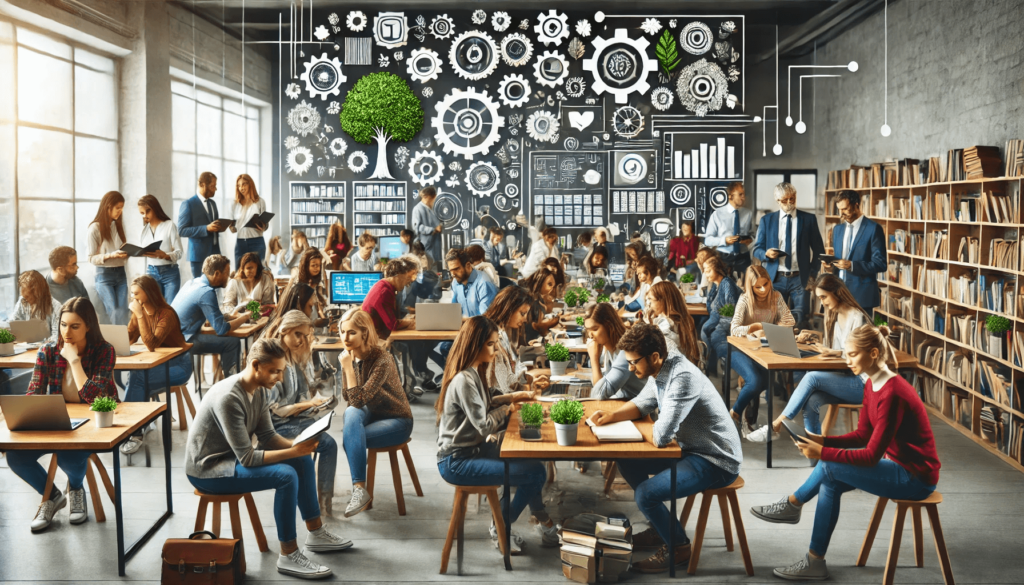Education for the Future: Rethinking Schools as Year-Round Learning Hubs

What if schools weren’t just for kids?
Imagine an education system where:
- Students learn at their own pace
- Adults can take free night classes for career advancement
- The community helps maintain and improve the school
In this blog, we’ll explore how rethinking education could create a stronger, smarter, and more connected society. With technology like AI-driven learning, skill-based education, and community involvement, we can create schools that benefit everyone.
Why Traditional Schooling Is Outdated
Our current education model was designed for an industrial era that no longer exists. Consider these limitations:
Industrial-Age Design in an Information Age
Most schools still operate on a factory model created in the 1800s:
- Age-based grouping regardless of individual development
- Standardized curricula delivered at uniform pace
- Fixed schedules that ignore natural learning rhythms
- Emphasis on compliance and memorization over creativity and critical thinking
As AI and automation transform the economy, these outdated approaches leave students unprepared for a world that values adaptability, collaboration, and lifelong learning.
Underutilized Community Assets
School buildings—often the largest public infrastructure in any neighborhood—sit empty for:
- Evenings (approximately 4-10 PM daily)
- Weekends (104 days annually)
- Summers and breaks (approximately 80 days annually)
This represents thousands of hours of unused community space while many neighborhoods lack:
- Affordable meeting spaces
- Adult education venues
- Cultural and recreational facilities
- Crisis shelters during emergencies
Disconnected Learning Communities
The separation between “school” and “community” creates artificial barriers:
- Parents often feel like outsiders in their children’s education
- Local expertise remains untapped as a teaching resource
- Students rarely apply learning to genuine community needs
- School improvements depend solely on district budgets rather than community investment
The Year-Round Learning Hub Vision
Imagine transforming schools into true community centers that serve as:
Personalized Learning Environments for Youth
Educational approaches shift to accommodate diverse learners:
- AI-assisted adaptive learning platforms that adjust to each student’s pace
- Project-based curriculum connected to real community needs
- Flexible schedules that optimize for learning, not administrative convenience
- Multi-age learning communities based on development, not birth year
Adult Education and Career Advancement Centers
During evenings and weekends, the same facilities become spaces for adult growth:
- Industry-recognized certification courses
- Digital literacy and technology skills training
- Financial literacy and entrepreneurship programs
- Language and cultural education for diverse communities
Community Gathering and Resource Spaces
Beyond formal education, learning hubs provide:
- Public makerspaces with tools and technology
- Intergenerational mentoring programs
- Health and wellness services
- Cultural events and celebrations
- Crisis response capacity during emergencies
How AI and Skill-Based Learning Can Revolutionize Education
New technologies can fundamentally transform the learning experience:
Adaptive Learning Systems
AI-powered platforms can:
- Provide real-time feedback on student progress
- Identify learning gaps and suggest targeted interventions
- Deliver content at optimal difficulty levels for each learner
- Free teachers to focus on mentorship, critical thinking, and complex instruction
Skill-Based Assessment
Moving beyond letter grades and standardized tests:
- Digital portfolios document mastery through real-world projects
- Competency tracking replaces arbitrary time-based advancement
- Microcredentials recognize specific skills across all ages
- Assessment becomes continuous rather than episodic
Learning Experience Design
Physical and digital environments designed for optimal learning:
- Flexible spaces adapt to various learning activities
- Technology enables personalized learning pathways
- Community integration breaks down classroom walls
- Design thinking principles guide ongoing improvement
Community-Driven Learning Hubs in Action
This vision isn’t utopian—communities worldwide are already implementing elements of learning hubs:
Case Study: Leander ISD Community Centers (Texas)
Leander school district transformed underutilized schools into multi-generational learning centers by:
- Partnering with community colleges for evening certification courses
- Converting unused classrooms into community health clinics
- Creating shared makerspaces for students and community members
- Developing income streams from facility rentals to fund improvements
Results include increased high school graduation rates, adult workforce participation, and dramatically reduced vandalism due to greater community ownership.
Case Study: Helsinki’s “Think Corner” Model (Finland)
Finland has reimagined schools as community knowledge centers where:
- Libraries double as community living rooms open 16 hours daily
- Local experts teach alongside certified teachers
- Students solve real municipal challenges through project-based learning
- Parent education opportunities run parallel to children’s classes
This approach has strengthened intergenerational bonds while making Finland a world leader in educational outcomes.
Case Study: Remake Learning Network (Pittsburgh, PA)
Pittsburgh transformed its post-industrial educational landscape by:
- Connecting schools with museums, libraries, and tech companies
- Creating a network of learning opportunities across community spaces
- Developing educator innovation fellowships for teachers
- Building shared technology resources accessible to all districts
This collaborative approach has revitalized struggling schools while ensuring equitable access to cutting-edge learning across socioeconomic divides.
How We Get There: A Practical Roadmap
Transforming our educational approach requires multi-level change:
Local School Level
Start with small, achievable steps:
- Pilot evening community access to specific school resources
- Invite local experts for guest teaching opportunities
- Identify underutilized spaces for community programming
- Establish a community-school liaison committee
District Level
Policy changes enable broader transformation:
- Revise facilities use policies to support extended access
- Create flexible staffing models for extended hours
- Develop community partnership frameworks
- Invest in technology infrastructure for adaptive learning
Community Level
Building support beyond school walls:
- Map community assets to identify potential partnerships
- Create volunteer certification programs for community teachers
- Develop shared funding models between schools and community organizations
- Document and celebrate early successes
The Path to a Learning Society
Reimagining schools as year-round learning hubs isn’t just about educational reform—it’s about creating a culture where learning is woven into the fabric of daily life for everyone.
When we break down the artificial barriers between “school” and “community,” we create stronger connections between generations, more resilient neighborhoods, and educational experiences that prepare all of us—not just young people—for a rapidly changing future.
On our Path to Unity, transforming education may be the single most powerful lever for creating communities where everyone can continue growing, contributing, and connecting throughout their lives.
How might you contribute to creating learning opportunities in your community?






Responses